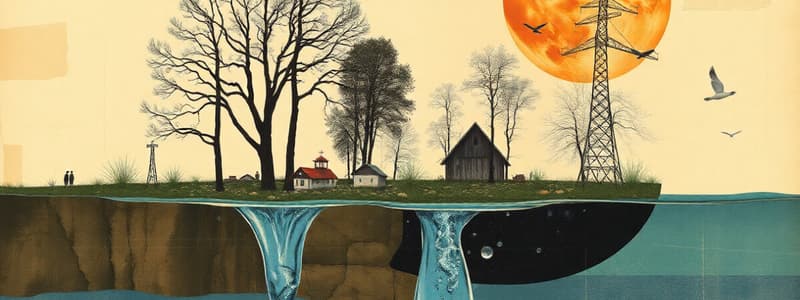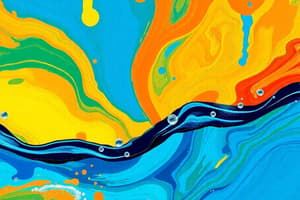Podcast
Questions and Answers
Describe the relationship between evaporation and transpiration in the hydrological cycle.
Describe the relationship between evaporation and transpiration in the hydrological cycle.
Both evaporation and transpiration return water to the atmosphere. Evaporation occurs from water bodies and the earth's surface. Transpiration is the process where plants release water vapor into the air.
Explain how increased industrial demand contributes to water scarcity.
Explain how increased industrial demand contributes to water scarcity.
Industrial processes consume significant amounts of water, leading to increased demand that can strain water resources and contribute to scarcity, especially in regions with limited supply.
How does changing lifestyle impact water usage?
How does changing lifestyle impact water usage?
Modern lifestyles often involve increased use of water-intensive appliances and habits, like frequent showers and use of gadgets, leading to higher overall water consumption.
What are the two strategies for effective water resource management?
What are the two strategies for effective water resource management?
What is the purpose of recharging groundwater, and name one method to achieve it?
What is the purpose of recharging groundwater, and name one method to achieve it?
Explain the concept of 'grey water' recycling and its benefit.
Explain the concept of 'grey water' recycling and its benefit.
How does water harvesting contribute to sustainable water use?
How does water harvesting contribute to sustainable water use?
Describe the role of the hydrological cycle in maintaining water as a renewable resource.
Describe the role of the hydrological cycle in maintaining water as a renewable resource.
Explain why energy conservation is vital considering the availability of resources.
Explain why energy conservation is vital considering the availability of resources.
How can using public transport contribute to energy conservation?
How can using public transport contribute to energy conservation?
What is the basic principle behind using solar panels to harness solar energy?
What is the basic principle behind using solar panels to harness solar energy?
Contrast conventional and non-conventional energy sources in terms of renewability.
Contrast conventional and non-conventional energy sources in terms of renewability.
Explain the function of wind turbines in generating electricity.
Explain the function of wind turbines in generating electricity.
Describe how tidal energy is harnessed and converted into electrical energy.
Describe how tidal energy is harnessed and converted into electrical energy.
What is geothermal energy, and how is it utilized?
What is geothermal energy, and how is it utilized?
How do biofuels contribute to reducing reliance on fossil fuels?
How do biofuels contribute to reducing reliance on fossil fuels?
Explain how nuclear power generates electricity.
Explain how nuclear power generates electricity.
What role does the Bureau of Energy Efficiency (BEE) play in promoting energy conservation in India?
What role does the Bureau of Energy Efficiency (BEE) play in promoting energy conservation in India?
How do CFL and LED bulbs differ in terms of energy consumption and environmental impact?
How do CFL and LED bulbs differ in terms of energy consumption and environmental impact?
Describe one way individuals can reduce energy waste in the transport sector.
Describe one way individuals can reduce energy waste in the transport sector.
Flashcards
Hydrological cycle
Hydrological cycle
Water circulates from land to sky and back. Solar heat evaporates water, and plants transpire.
Water harvesting
Water harvesting
Water is collected from surfaces and stored for later use or to replenish groundwater.
Groundwater recharge
Groundwater recharge
Water naturally moves downward from surface water to groundwater.
Water resource management
Water resource management
Signup and view all the flashcards
What is energy?
What is energy?
Signup and view all the flashcards
Conventional energy sources
Conventional energy sources
Signup and view all the flashcards
Solar energy
Solar energy
Signup and view all the flashcards
Geothermal Power
Geothermal Power
Signup and view all the flashcards
Tidal/Ocean energy
Tidal/Ocean energy
Signup and view all the flashcards
Conserve Energy at Home
Conserve Energy at Home
Signup and view all the flashcards
Bureau of Energy Efficiency (BEE)
Bureau of Energy Efficiency (BEE)
Signup and view all the flashcards
CFL Bulbs
CFL Bulbs
Signup and view all the flashcards
Bioethanol
Bioethanol
Signup and view all the flashcards
Study Notes
Water and Its Importance
- Water is essential for life, renewable, and reusable.
- Approximately three-fourths of the Earth is covered by water.
- Less than 1% of the water on Earth is fresh and usable for living organisms.
- The hydrological cycle involves water circulating between land and sky; solar heat causes evaporation, and plants release water through transpiration.
Factors Increasing Water Demand
- A growing population leads to increased water demand for drinking, sanitation, domestic use, irrigation, and industries.
- Expansion of irrigation leads to increases in water demand, due to seasonal rainfall variations, uncertainty of rainy seasons, the growing demand of water for commercial crops and due to changing crop patterns.
Increasing Demands
- Increased demand by industry, with the largest proportion of water being consumed by thermal power plants.
- Changing lifestyles involving many appliances and fittings which also contribute to raising demand.
Methods of Water Conservation
- Agricultural lands near cities can use municipal wastewater for irrigation.
- Recycling household "grey water" reduces the need for pure water.
- Used bath and shower water can be used for watering plants.
- Water harvesting collects rainwater for later use or to replenish groundwater.
- Groundwater recharge occurs when surface water moves downward into groundwater.
Water Resource Management
- Key strategies involve reducing water loss/wastage and removing pollutants.
- River pollution stems from industrial/urban effluents, bathing, washing, and waste disposal.
- The Government of India has launched Ganga Action Plan (GAP) and Yamuna Action Plan (YAP) to clean up rivers.
Energy and Its Sources
- Energy is the capacity to do work and can be transformed but not created, destroyed, or recycled.
- Energy sources are classified as renewable or non-renewable.
- Society uses energy for cooking, running appliances, transport, pumping water, and industrial processes.
- Conventional energy sources are fossil fuels, which are limited and non-renewable.
- Coal is mined and transported, found in Raniganj, Jharia, and Dhanbad in Bihar.
- Oil is pumped from wells and transported; used in automobiles and airplanes, found along the west coast and in Digboi oil fields, Assam.
- Natural gas includes LPG and CNG, LPG is in cooking cylinders, CNG in public transport. CNG stands for Compressed Natural Gas and LPG stands for Liquified Petroleum Gas.
Alternative Energy Sources
- Due to increased fossil fuel consumption, alternative non-conventional sources are needed.
- Alternative sources consist of Solar, Wind, Hydel, Tidal, Geothermal, and Biomass energy.
- Conventional energy uses have been practiced for a long time.
- Non-conventional sources of energy are not used frequently and in large scale, and their uses are more recent.
- Most conventional energy besides hydel power is costly, but non-conventional energy is cheaper.
- Solar energy harvested through "solar panels" is widespread, non-polluting, and free.
- Wind turbines rotate magnets to create electricity.
- Many dams store water to convert potential energy to kinetic energy for electricity generation.
- Tidal energy can be transformed into electrical energy.
- Geothermal power utilizes the Earth's heat, which is readily accessible and used to generate electricity.
- Biomass, being renewable, will be available as long as plants grow. Fast-growing trees such as Euphorbia and Jatropha, get planted.
Biofuels
- Bioethanol is an alcohol made by fermentation.
- It is made from carbohydrates in sugar or starch crops.
- Bioethanol made from corn or sugarcane.
- Bioethanol can derive from beet root through fermentation and distillation.
- Bioethanol and is usable as a fuel for vehicles in its pure form.
- Biodiesel is made from vegetable oils and animal fats.
- Some of India's oil-yielding trees for biodiesel are Ratanjot, Nagchampa, and Rubber seeds.
Nuclear Energy
- Nuclear power generates heat and electricity using exothermic nuclear processes, including fission, decay, and fusion.
Energy Conservation
- Limited resources and increasing demands require conserving energy and improving efficiency.
- Saving energy starts at home, by switching off lights and fans when not in use, minimize common workspace use, using fuel efficient stoves for cooking and use dry branches for tree burning.
- At work, use carpools, switch off unused lights/fans, and turn off computers when not in use.
- Use public transport, maintain lower car speeds, drive moderately, and check vehicles for fuel leaks.
- Turn off vehicle engines at stops to avoid idling.
- CFL’s have mercury, is an element essential to the operation of fluorescent lighting.
- Incandescent bulbs are replaced by CFL (Compact Fluorescent Light Bulbs) & LED (Light Emitting Diode) bulbs.
- CFL bulbs use less electricity: 75% less and LED bulbs use less energy and are lead free, environmentally friendly.
- The Bureau of Energy Efficiency (BEE), created in 2002.
- The BEE develops programs to increase energy conservation and efficient use in India.
- The transport sector is the fastest growing source of greenhouse gases.
- Over 85% of greenhouse gas emissions from transport are CO2 from road transport.
- Reducing energy waste requires improving energy efficiency.
Studying That Suits You
Use AI to generate personalized quizzes and flashcards to suit your learning preferences.





